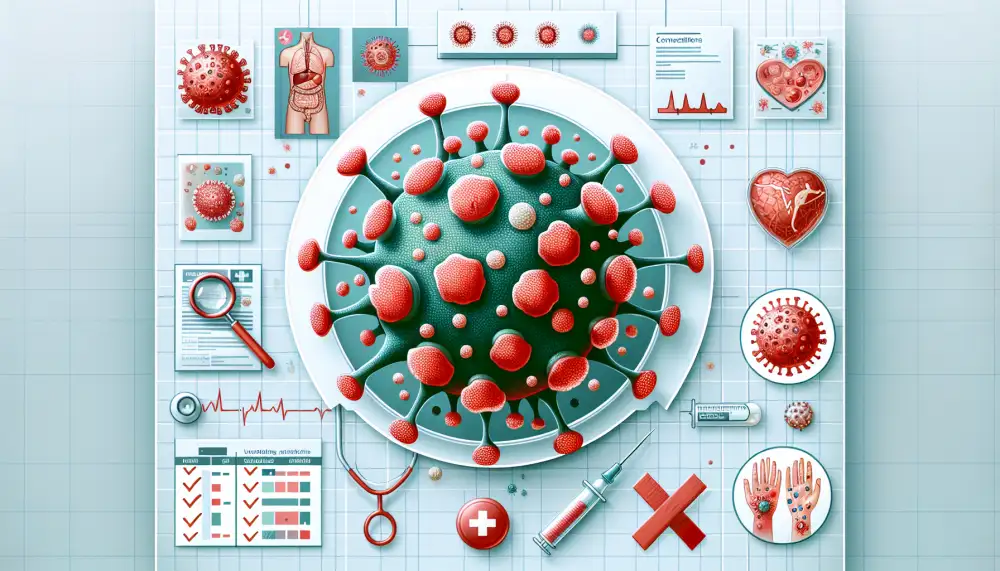Smallpox Pictures: A Stark Reminder of Vaccination's Power

A gruesome history
For centuries, smallpox ravaged civilizations, leaving a trail of unspeakable suffering in its wake. Images from this era serve as stark reminders of the disease's devastating power. We see the characteristic pox marks, disfiguring pockmarks that scarred survivors for life. Portraits of royalty, once symbols of power and prestige, became testaments to smallpox's indiscriminate reach. We see the fear in the eyes of those afflicted, the despair etched on the faces of families torn apart. Medical illustrations, while aiming to document and understand the disease, cannot help but convey the sheer horror smallpox inflicted. These images are not for the faint of heart, but they are essential viewing. They force us to confront the very real human cost of this disease and remind us of the immense progress made in its eradication.
Early depictions
Prior to the advent of photography, the visual documentation of smallpox relied heavily on artistic interpretations and written descriptions. Artists often depicted individuals afflicted with the disease, showcasing the characteristic pustules and skin lesions. These depictions served not only as artistic expressions but also as a means of recording and disseminating knowledge about the disease's appearance. One notable example is the "Shitala" paintings from India, which portrayed the goddess of smallpox and aimed to ward off the disease. Similarly, European artists created numerous illustrations and engravings depicting smallpox patients, often in medical texts or treatises. While these early depictions may lack the clinical accuracy of modern photographs, they provide valuable insights into the historical understanding and visual representation of smallpox before the development of photography.
Medical illustrations
Medical illustrations have played a crucial role in understanding and combating smallpox. These illustrations, often highly detailed and sometimes quite graphic, provide a visual record of the disease's progression. From the characteristic rash to the pustules that formed, medical artists meticulously documented the different stages of smallpox. These images served several purposes. They aided physicians in diagnosing smallpox, differentiating it from other diseases with similar symptoms. Medical students relied on these illustrations to learn about the disease's appearance and progression. Beyond their educational value, smallpox illustrations also served as powerful public health tools. They were used in medical texts, journals, and even on posters to raise awareness about the disease. The graphic nature of these images, while potentially disturbing, conveyed the severity of smallpox and the importance of vaccination. Today, with smallpox eradicated, these illustrations serve as historical artifacts. They offer a glimpse into the devastating impact of the disease and the efforts to combat it. However, it's important to note that some people may find these images disturbing due to their graphic content. Researchers and historians continue to study these illustrations, analyzing their accuracy and the evolving understanding of smallpox over time.

Smallpox pustules
Smallpox pustules were a key symptom of smallpox, a deadly disease caused by the variola virus. Pictures of smallpox often focus on these pustules, as they were a defining characteristic of the disease. The pustules began as flat, red lesions that evolved over time. In the early stages, they resembled small, firm bumps, similar in appearance to chickenpox but with distinct differences. As the disease progressed, the pustules filled with a thick, opaque fluid, giving them a pearly or greyish appearance. These pustules were often deeply embedded in the skin and had a distinctive dimple in the center. The number of pustules could range from a few to thousands, covering the entire body in severe cases. The development and progression of smallpox pustules were accompanied by other symptoms, including high fever, headache, and body aches. Pictures of smallpox pustules can be disturbing to view, serving as a stark reminder of the devastating impact this disease had on humanity.
| Feature | Smallpox Pictures |
|---|---|
| Availability | Widely available online, but ethically sensitive to view and share. |
| Purpose | Historically used for medical documentation and education. Today, primarily for historical and public health awareness purposes. |
Devastating effects
The visual documentation of smallpox's impact is as chilling as it is extensive. Pictures of smallpox, often taken at the height of the disease, reveal the brutal reality of this ancient scourge. The rash, initially resembling small, flat red spots, would develop into firm, pus-filled lesions covering the body. These images capture the intense suffering smallpox inflicted: fever, body aches, and the agonizing pain from the characteristic pox. Beyond the physical torment, pictures of smallpox also hint at the psychological toll. The disfigurement, often leaving deep pitted scars, carried profound social stigma, leading to isolation and despair. These photographs stand as stark reminders of smallpox's devastating effects, not just on individuals but on entire communities ravaged by its spread. They serve as powerful testaments to the importance of vaccination, a triumph of science that ultimately eradicated this deadly disease.
Eradication efforts
The global eradication of smallpox stands as a testament to the power of concerted human effort and scientific advancement. The World Health Organization (WHO) spearheaded the Intensified Smallpox Eradication Programme in 1967, marking a turning point in the fight against the disease. This ambitious initiative hinged on a multi-pronged approach. Mass vaccination formed the cornerstone of the strategy, with millions around the world receiving the smallpox vaccine. Health workers meticulously tracked the virus's spread, isolating infected individuals to curb transmission chains. Pictures from this era often depict healthcare workers administering vaccinations in remote villages and communities, highlighting the extensive reach of the eradication campaign. Other poignant images capture the devastating effects of smallpox on the human body, serving as stark reminders of the disease's eradicated status. The last naturally occurring case of smallpox occurred in Somalia in 1977, marking a pivotal moment in medical history. The WHO declared smallpox eradicated in 1980, a triumph for public health that continues to inspire disease eradication efforts today.

Vaccination scars
Smallpox, once a dreaded disease, left its mark on humanity in the form of vaccination scars. These scars, often found on the upper arm, are a testament to the success of vaccination in eradicating smallpox. Pictures of smallpox often depict individuals with characteristic pockmarks covering their bodies, a stark reminder of the disease's devastating effects.
Vaccination, using the related vaccinia virus, offered immunity and left a small, round scar at the vaccination site. Pictures of smallpox vaccinations show the process: a sharp needle dipped in vaccinia virus, pricking the skin multiple times to trigger an immune response. While smallpox has been eradicated, the vaccination scars remain for many, a visible reminder of the disease's history and the triumph of vaccination. These scars serve as a conversation starter, prompting discussions about the importance of vaccines in public health.
Reminders of the past
The scars left behind, both physically on the bodies of survivors and etched into our collective memory, serve as stark reminders of the smallpox's devastating power. Before its eradication, photography and detailed illustrations were crucial tools in documenting the disease's progression. These images, often unsettling to the modern eye, show the characteristic pox marks that ravaged the skin, leaving many with permanent disfigurement. Beyond the individual suffering they capture, these pictures served a greater purpose. They were vital for educating the public, training healthcare workers, and tracking the disease's spread. Today, these images stand as historical artifacts, testaments to the suffering endured and the triumph of global eradication efforts. They remind us of the importance of vaccination and public health measures in safeguarding humanity from such threats. While smallpox is gone, its visual legacy serves as a powerful reminder of the importance of vigilance and continued investment in global health security.

Ethical considerations
The use of smallpox pictures and images, particularly those depicting human suffering, raises significant ethical concerns. While these visuals can be powerful tools for education and historical documentation, it's crucial to approach their use with sensitivity and responsibility.
The graphic nature of smallpox imagery can be deeply disturbing and potentially triggering for viewers, especially survivors and those who have lost loved ones to the disease. Sharing such images without appropriate context or warnings can perpetuate fear, stigma, and discrimination.
Furthermore, the exploitation of smallpox imagery for sensationalistic purposes or personal gain is ethically unacceptable. It's essential to prioritize the respect and dignity of those affected by smallpox and to avoid any use of imagery that could be perceived as exploitative or insensitive.
When using smallpox pictures, it's crucial to consider the audience and the purpose of the content. Educational materials should use imagery judiciously, providing sufficient context and warnings for viewers. Historical contexts should prioritize accuracy and sensitivity, avoiding the perpetuation of harmful stereotypes or misinformation.
Ultimately, the ethical use of smallpox imagery requires careful consideration, empathy, and a commitment to responsible communication.
Educational value
Smallpox pictures, though often unsettling, offer a powerful educational tool. They provide a visceral and unforgettable understanding of the disease's impact, which written descriptions alone cannot replicate. Seeing the characteristic pox marks, skin lesions, and potential for disfigurement drives home the severity of smallpox, especially for visual learners. These images can be instrumental in public health education, illustrating the importance of vaccination.
Historically, smallpox pictures were crucial for disease identification in the absence of modern diagnostic tools. Medical students and practitioners relied on these images to recognize smallpox and differentiate it from other diseases with similar symptoms. Today, they serve as a stark reminder of smallpox's devastating history, emphasizing the success of vaccination efforts that led to its eradication.
However, it's important to use discretion when displaying such images. Graphic content can be disturbing, especially for young audiences or those unfamiliar with the disease. Clear context and sensitive presentation are crucial to ensure the educational value outweighs any potential distress.

Public health legacy
The stark visual documentation of smallpox, both in illustrations and early photographs, played a crucial role in shaping public health responses to the disease. These images, often unsettling in their detail, brought the devastating reality of smallpox into sharp focus for the public. This visual evidence was instrumental in garnering support for vaccination campaigns, even in the face of early skepticism and fear.
The iconic image of a smallpox victim, covered in the characteristic pustules, became a powerful symbol of the disease's potential to disfigure and kill. These images served as a stark reminder of the importance of prevention and helped to overcome resistance to vaccination, ultimately paving the way for the global eradication of smallpox in 1980. The legacy of these images extends beyond the eradication of smallpox, serving as a reminder of the power of public health interventions and the importance of visual communication in overcoming health challenges.
Published: 30. 06. 2024
Category: Health



